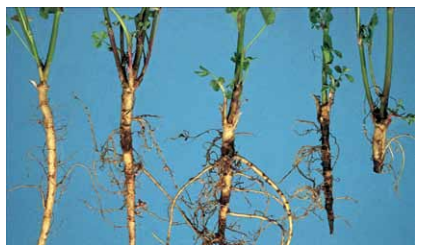Excessive Moisture Has Benefits and Drawbacks for Alfalfa Producers
Rainfall over the past couple of months, while beneficial to alfalfa growth and suppression of some insect pests, can cause additional problems.
Figure 1.
Excessive rainfall in many areas of the state can be attributed to continued alfalfa growth; however, wet conditions has limited timely access to some fields delaying harvest and reducing forage quality (Fig. 1).
While the delay in harvest allows for continued growth and increase in plant material, it also inhibits airflow. The lack of airflow and continued moisture can create optimum conditions for disease occurrence.
Disease can be a limiting factor in alfalfa production. In both hay and seed production, diseases can cause serious losses in yield, quality, and stand persistence. Death of plants is sometimes quick and obvious, but more often plant-kill by diseases is not so obvious. Diseases can kill 5-10 percent of the plants in a stand each year. In many cases, alfalfa plants live for several years after becoming infected by diseases. This reduces the vigor and competitiveness of infected plants; thus, weeds are better able to compete.
Unfortunately, many of the diseases found in Oklahoma soils can lay dormant for many years waiting for optimum environmental conditions to become active. Root and Crown diseases such Phytophthora root rot (Fig. 2) can cause plant death in seedling and established stands quickly. Other diseases such as Anthracnose and leaf spot (Fig. 3 & 4) can cause production and stand losses over time. Few economical control options are available for diseases once they’re present in a field, but knowing which diseases are present can help you select resistant varieties for future planting.
Figure 2. Phytophthora root rot in field study, Stillwater, OK. Center row is resistant.
Phytophthora root rot. As the disease progresses (left to right), lesions develop, and the taproot rots off. (Photo credit: Alfalfa Management Guide, American Society of Agronomy).
Figure 3. Anthracnose
Figure 4. Lepto leafspot
The most effective means of controlling diseases in alfalfa is the use of multiple - resistant varieties. Most varieties released in recent years possess adequate resistance to diseases across most conditions in Oklahoma. Another layer of protection is to minimize plant stress using appropriate management practices. These include site selection (well-drained soil), adequate soil pH and fertility, proper stand establishment, timely harvest management, wheel traffic management, weed and insect control.
Identifying pathogens that cause symptoms on plants can be difficult. Producers are encouraged to consult their County Extension Office or the Plant Disease and Insect Diagnostic Laboratory (PDIDL), Entomology and Plant Pathology at OSU for assistance in determining causal agents.





